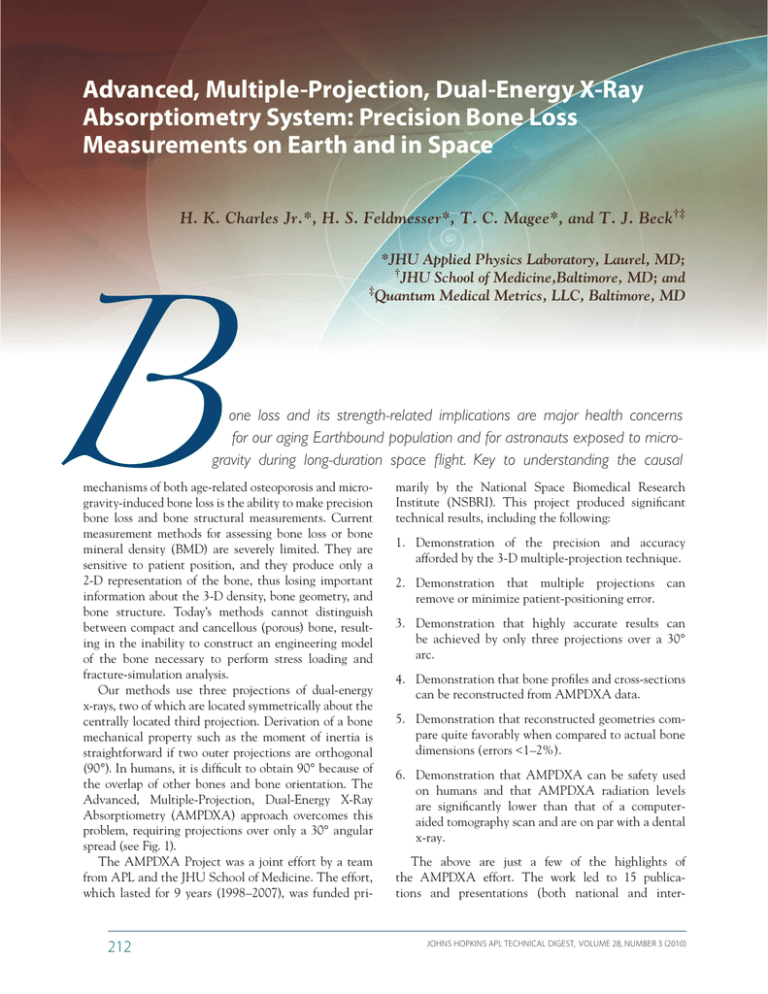Advanced, Multiple-Projection, Dual-Energy X-Ray Absorptiometry System: Precision Bone Loss
advertisement

H. K. CHARLES et al. B Advanced, Multiple-Projection, Dual-Energy X-Ray Absorptiometry System: Precision Bone Loss Measurements on Earth and in Space H. K. Charles Jr.*, H. S. Feldmesser*, T. C. Magee*, and T. J. Beck†‡ *JHU Applied Physics Laboratory, Laurel, MD; †JHU School of Medicine,Baltimore, MD; and ‡Quantum Medical Metrics, LLC, Baltimore, MD one loss and its strength-related implications are major health concerns for our aging Earthbound population and for astronauts exposed to microgravity during long-duration space flight. Key to understanding the causal mechanisms of both age-related osteoporosis and microgravity-induced bone loss is the ability to make precision bone loss and bone structural measurements. Current measurement methods for assessing bone loss or bone mineral density (BMD) are severely limited. They are sensitive to patient position, and they produce only a 2-D representation of the bone, thus losing important information about the 3-D density, bone geometry, and bone structure. Today’s methods cannot distinguish between compact and cancellous (porous) bone, resulting in the inability to construct an engineering model of the bone necessary to perform stress loading and fracture-simulation analysis. Our methods use three projections of dual-energy x-rays, two of which are located symmetrically about the centrally located third projection. Derivation of a bone mechanical property such as the moment of inertia is straightforward if two outer projections are orthogonal (90°). In humans, it is difficult to obtain 90° because of the overlap of other bones and bone orientation. The Advanced, Multiple-Projection, Dual-Energy X-Ray Absorptiometry (AMPDXA) approach overcomes this problem, requiring projections over only a 30° angular spread (see Fig. 1). The AMPDXA Project was a joint effort by a team from APL and the JHU School of Medicine. The effort, which lasted for 9 years (1998–2007), was funded pri- 212 marily by the National Space Biomedical Research Institute (NSBRI). This project produced significant technical results, including the following: 1. Demonstration of the precision and accuracy afforded by the 3-D multiple-projection technique. 2. Demonstration that multiple projections can remove or minimize patient-positioning error. 3. Demonstration that highly accurate results can be achieved by only three projections over a 30° arc. 4. Demonstration that bone profiles and cross-sections can be reconstructed from AMPDXA data. 5. Demonstration that reconstructed geometries compare quite favorably when compared to actual bone dimensions (errors <1–2%). 6. Demonstration that AMPDXA can be safety used on humans and that AMPDXA radiation levels are significantly lower than that of a computeraided tomography scan and are on par with a dental x-ray. The above are just a few of the highlights of the AMPDXA effort. The work led to 15 publications and presentations (both national and inter- JOHNS HOPKINS APL TECHNICAL DIGEST, VOLUME 28, NUMBER 3 (2010) AMPDXA FOR PRECISION BONE LOSS MEASUREMENTS Miniature, Lightweight Tube (No Rotating Anode) +15° +0° Multiple High-Efficiency Sources –15° Figure 2. Schematic diagram of a new compact, multiple-energy x-ray source that could revolutionize dual-energy x-ray absorptiometry (DEXA) and other x-ray technologies. (Adapted from fig. 1 of U.S. Patent 7,186,022 B2.) national). Five patents were issued, and several more are pending. Figure 1. (Upper) Artist’s illustration of a proposed commercial AMPDXA scanner requiring no rotation of the x-ray tube or head. The scanner uses three fixed x-ray sources with an adjustable line detector array for bone axes alignment. The mechanical simplicity of the device should allow for ease of manufacture, thus facilitating commercialization. (Lower) AMPDXA multiple-projection (+15°, 0°, –15°) processed BMD images of a human femur (reconstructed from individual slices of AMPDXA human test bed data). The experimental team continues to meet regularly to foster technology transfer and to look for opportunities to apply the AMPDXA technology outside of the medical field. A new dual high-energy x-ray source (patented under the AMPDXA effort) is being considered for developmental funding (Fig. 2). The source has the potential for application in homeland security efforts and in materials processing and analysis. New collimation methods with application to standard commercial x-ray systems are being investigated. For further information on the work reported here, see the references below or contact harry.charles@jhuapl.edu. 1Charles, H. K., Jr., Chen, M. H., Spisz, T. S., Beck, T. J., Feldmesser, H. S., Magee, T. C., and Huang, B. P., “AMPDXA for Precision Bone Loss Measurements on Earth and in Space,” Johns Hopkins APL Technical Digest, 25(3), 187–200 (2004). 2Spisz, T. S., Beck, T. J., Feldmesser, H. S., Chen, M. H., Magee, T. C., Bade, P. R., and Charles, H. K., Jr., “Determination of Bone Structural Parameters from Multiple Projection DXA Images,” in Medical Imaging 2004: Physiology, Function, and Structure from Medical Images, A. A. Amini and A. Manduca (eds.), Proc. of SPIE, Vol. 5369, SPIE, Bellingham, WA, pp. 730–741, doi: 10.1117/12.535361 (2004). JOHNS HOPKINS APL TECHNICAL DIGEST, VOLUME 28, NUMBER 3 (2010) 213­­



